The Ultimate Guide to Tayrona National Park

Tayrona National Park, on the Caribbean coast, is one of the most celebrated national parks in Colombia. Not only is it home to some of the most gorgeous beaches in the country, but it’s also rich in culture and wildlife. Here’s what else you need to know before you visit.
Tempted to visit? You can do so with a local insider as part of a small group of like-minded travellers on Culture Trip’s exclusive eight-day Colombian Caribbean tour.
History of the park
Tayrona was established in 1964 and turned into a national park in 1969 to protect and promote ecology and archaeology; it’s of great natural and cultural importance, the pre-Hispanic Tayrona tribe called this area home and built small villages and communities here. Descendants of this tribe, called Koguis, plus three other groups still live here and maintain their cultures and traditions.

How to get to Tayrona National Park
To get to Tayrona National Park, you can drive or take a bus from Santa Marta (the journey takes about an hour) or jump in a boat from Taganga. The entrance fee is around 60,000 Colombian pesos (roughly $15) for foreign visitors and less for Colombian nationals. Once in the park, there are two options for the journey to the beach: hiking or taking a van from the entrance.
Main areas in Tayrona National Park
This park is spread over a large stretch of coast, so there are plenty of beaches to explore. After a 45-90 minute picturesque jungle hike from the entrance, you’ll arrive at a small village called Arrecifes. This village has restaurants, shops, accommodation and free-to-use lockers – padlocks aren’t included so bring one or buy one from a store in the park. Arrecifes has a beautiful beach area, but swimming is prohibited due to the strong current and huge waves.
A 20-minute walk from Arrecifes takes you to La Piscina, another small village with a variety of accommodation and restaurants. Here, swimming is permitted in natural swimming pools, while La Piscina is also home to one of many coral reefs in Tayrona – perfect for snorkeling with rays, lobsters and much more.
Another 15-minute walk from La Piscina takes you to the next village: El Cabo. This picturesque beach is one of the most recognizable in the park and swimming is permitted here, too – it’s a great place to snorkel and marvel at the Caribbean reefs and tropical fish. El Cabo also has a number of restaurants and accommodation types on offer, including hammocks, cabanas and a camping area.

Things to do in Tayrona National Park
Tayrona has a number of fun things to do, including snorkeling coral reefs, swimming, hiking or simply relaxing. There are two main hiking trails from El Cabo – one to El Pueblito and another called the Nine Stones Hike (Nueve Piedras), the latter following egg-like stone markers.
El Puebilto is a one- to two-hour hike of 2.4km (1.5mi). This town is an archaeological site and gives you an insight into how indigenous communities once live.
Wildlife in Tayrona National Park
Tayrona is home to more than 105 species of mammals including three species of monkey – red howler, capuchin and the cotton-top tamarin – as well as 300-plus bird species, 70 types of bat, 31 reptile species, 110 different types of coral, 401 sea and river fish, and more than 770 plant species.

Useful tips when visiting Tayrona National Park
To avoid the crowds, visit the park in the low season – February to November – and arrive early to get a good spot and find accommodation. While you can purchase food and drink in the park, it is significantly higher in price than outside so it’s advised to bring food and drink for your stay – note that no alcohol is allowed to be brought into the park.
You can find cheap food in some spots here, including El Cabo, where you can purchase typical Caribbean-influenced meals such as fresh fish, patacones and ceviche, as well as fresh juices from food stalls. Sunscreen, water and bug spray are essentials for your visit.
While Tayrona National Park is a beautiful and picturesque place to visit, remember it’s a sacred place for many indigenous tribes – treat it with respect and take all trash and belongings home with you.













